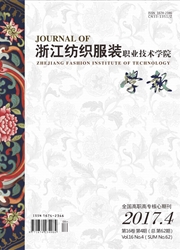

 中文摘要:
中文摘要:
研究了发酵还原法建蓝的各种影响因素,比较了发酵还原法和化学还原法染色真丝的性能。结果表明:地黄根和蜂蜜是植物靛泥发酵还原理想的酵母剂和酵母培养剂,当植物靛泥用量为30 g/L时,合理的蜂蜜用量为8~16 g/L,地黄根用量为4~6 g/L,生石灰用量为2-3 g/L,理想的发酵还原温度在20℃~30℃,发酵还原时间需1~2天;在靛泥用量相同情况下,发酵还原法染色的真丝织物K/S值略高于化学还原法染色的织物,染色牢度及织物染色受损情况两者接近,均符合服用要求,发酵还原法对环境污染少,是可推广使用的生态还原法,适用于家庭或工作室建蓝。
 英文摘要:
英文摘要:
In this paper, the influence factors of indigo dyes ’ reduction by fermentation method were studied, and the properties of silk dyed by fermentation reduction and chemical reduction were compared. The results show that rehmannia root and honey are the ideal yeasts and yeast culture agents for the fermentation of indigo mud. The optimum conditions are reducing at 20℃~30℃ with 30g/l indigo mud, 8~16g/L honey, 4~6g/L re- hmannia root, 2-3 g /L quick lime and 1~2 days. With the same dosage of indigo mud, the K/S value of the silk fabric dyed by the fermentation reduction method is slightly higher than that of the fabric dyed with the chemical reduction method. The dyeing fastness and the damage of fabric dyeing are almost the same, and both of them conform to the requirements of wearing. The fermentation reduction method is less polluting to the en-vironment and is an ecological reduction method which can be used widely. It is suitable for families or studios to reduce the indigo dyes.
 同期刊论文项目
同期刊论文项目
 同项目期刊论文
同项目期刊论文
 期刊信息
期刊信息
